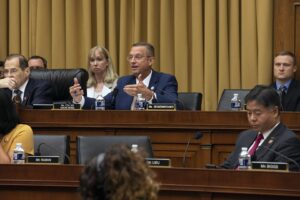
NASHVILLE (BP) – The decades-long increase in the number of religiously unaffiliated Americans in surveys – sometimes called the rise of the “nones” – may be slacking off, according to a recent analysis, but the reasons for that remain unclear.
“The rise of the nones may be largely over now. At least it won’t be increasing in the same way it did in the prior 30 years,” Ryan Burge, an American Baptist pastor and data analyst on religion, wrote at graphsaboutreligion.com in May.
Burge’s best guess for why is that marginally attached people switched to “no religion” on surveys for so long that eventually very few marginally attached respondents remained.
“All you had left were the very committed religious people who likely won’t become nones for any reason,” Burge wrote. “The loose top soil has been scooped off and hauled away, leaving nothing but hard bedrock underneath.”
To arrive at his conclusion that the rise of the nones has leveled off, Burge analyzed three studies: the 2023 Cooperative Election Study with 25,400 respondents, the General Social Survey and Pew’s National Public Opinion Reference Survey.
The share of CES respondents claiming to be non-religious moved from 34 percent in 2020 to 36 percent in 2021 to 35 percent in 2022 to 36 percent in 2023. By comparison, the number jumped from 21 percent in 2008 to 30 percent in 2013 to 35 percent in 2019.
Among Gen Z – those born in 1996 or later – in particular, the share who were nones was 45 percent in 2020, 48 percent in 2022 and 42 percent in 2023, Burge noted from the CES.
Shane Pruitt, national Next Gen director with the North American Mission Board, said a leveling off of nones may correspond with what he has seen experientially. Students are moving from noncommitment to faith.
“God is up to something special with teenagers, college students and young adults,” Pruitt said in a statement to Baptist Press. “I’ve personally seen more young people make professions of faith in Jesus for salvation and surrender to a calling of ministry in the last four years of ministry than the previous 20 years of ministry combined.”
Young people are “coming to the end of themselves at a much earlier age,” Pruitt said, and they are looking for hope, answers and truth. When they don’t find that in the world, “then anxiety rates go up, depression rates go up, and suicide attempts go up.”
That leaves the church with an opportunity to share the Gospel with a seeking generation, Pruitt said. “They’re ready, and once they truly understand the Gospel, they’re going all in with full obedience and surrender.”
Paul Worcester, NAMB’s national collegiate director, said he can list multiple SBC collegiate ministries that saw 40 to 80 students make professions of faith in Christ this past school year.
“We are seeing a growing movement of collegiate leaders who have a relentless focus on equipping students to become laborers on campus, and the results are exponential spiritual multiplication,” Worcester told BP. “The best person to reach a student with the Gospel is another student.”
Trevin Wax, vice president of research and development at NAMB, observed that the “strangeness” of church has become its appeal for Gen Z, given that fewer of them have any family background in church.
“When young people accept the invitation to visit a church, they’ve already committed to experiencing something unusual,” Wax wrote for The Gospel Coalition in April. “Attempts at being overly accommodating or making the church seem ‘cool’ come off as desperate and insecure.”
Young people, Wax wrote, want to be “courted by the church, welcomed into fellowship, entrusted with responsibility and shown they matter.”
“But more than anything, they want to be ushered into splendor, not superficiality. They’re looking for an antidote to the shallow life of swiping and scrolling through endless entertainment.”
The reality of difficult fields remains, though, as some are less ripe for harvest than others.
“In my estimation, I don’t think we are yet seeing a leveling off of nones,” Tommy Johnson, regional campus minister at Western Kentucky University since 2004, told BP. “That impression is not from a research study but from observation of going out on campus weekly with our students to do spiritual surveys.”
Janie B. Cheaney, a commentator for The World and Everything in It podcast, noted the rise in Americans identifying as religiously unaffiliated coincided with a decline in public engagement in general, particularly as the gap was filled with technology.
“Social trends should concern us but not defeat us,” Cheaney said May 29. “Whether the church continues to shrink or bursts out in revival – for which we fervently pray – its relevance will stand as a rebuke or rescue for this crooked generation. If Egyptian bondage and Babylonian captivity couldn’t forestall God’s purpose, neither will smartphones.”















